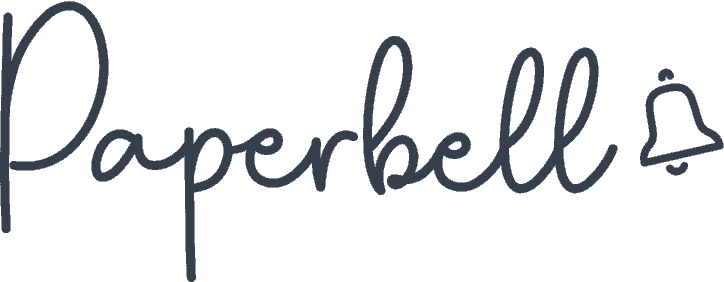You’ve just had a great conversation with a potential client. There was a connection, and you both feel this could be a match. So what’s next?
Having the right coaching package ready can be the only difference between “I’ll think about it” and “Where do I sign?” It gives the coaching relationship a clear structure and establishes you as an expert.
Ultimately, it turns you from a nice person to chat with into a professional coach your client can trust to deliver transformation.
In this article, we’ll look at everything you need to know about building life coaching packages, pricing them right, and using them to get clients.
Why Create Packages as a Coach?
If you’re working as a coach, that means you’re a service provider. You’re not just working with clients but also managing a business, usually as a solopreneur.
Now, if you want to spend less time getting clients and more time working with those clients, you need to make what you offer crystal clear.
Think about it this way: has anyone ever told you they’re an expert at everything and made you reach for your credit card? Probably not.
But when someone tells you they specialize in something you happen to be looking for, when they show you a tailor-made plan with a clear outcome, it almost feels like a God-given synchronicity.
Except it isn’t—it’s a well-designed package.
Your life coaching package should create the necessary restrictions to make the buying decision easier and show your clients what makes you unique. It should also set expectations for what it’s like to be working with you.
Your rates should reflect the expertise and perspective you worked hard to earn throughout your career and the work you put into the coaching relationship (not just during your sessions).
If you charge by the hour, your clients might try a session or two to “see how it goes,” but they won’t commit to their transformation. Unless you lay out in front of them where their coaching journey begins and ends.
And that’s exactly what a structured life coaching package can do.
Create and Sell Stunning Coaching Packages With Paperbell
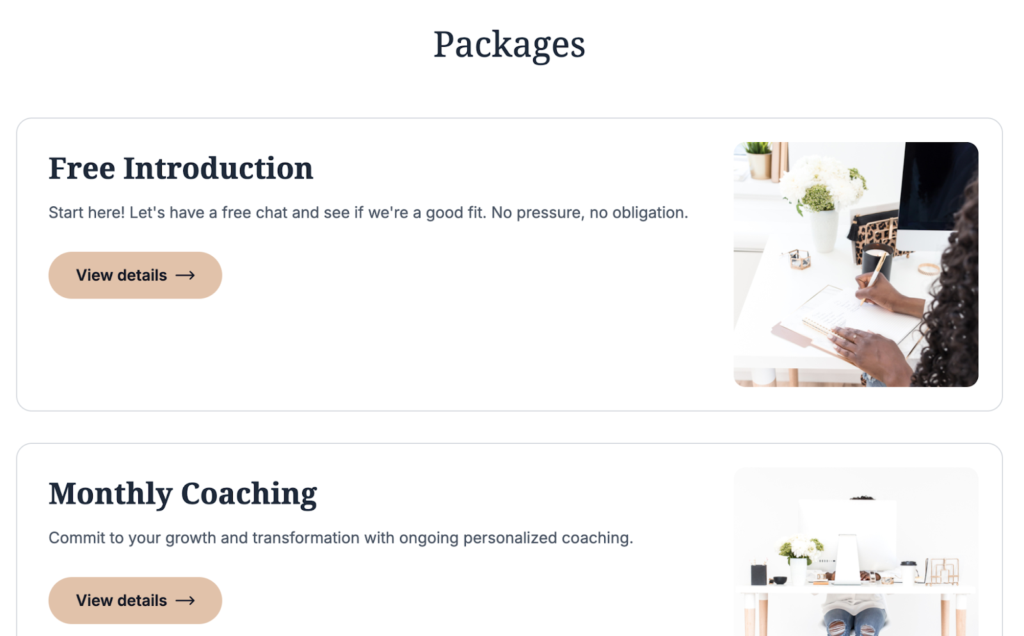
Creating a variety of coaching packages and turning them into landing pages is a no-brainer with Paperbell.
It’s an all-in-one coaching website and client management tool with all the features you need, with none of the complicated tech. You just need to fill out a form, and Paperbell automatically creates a new package that is ready for bookings.
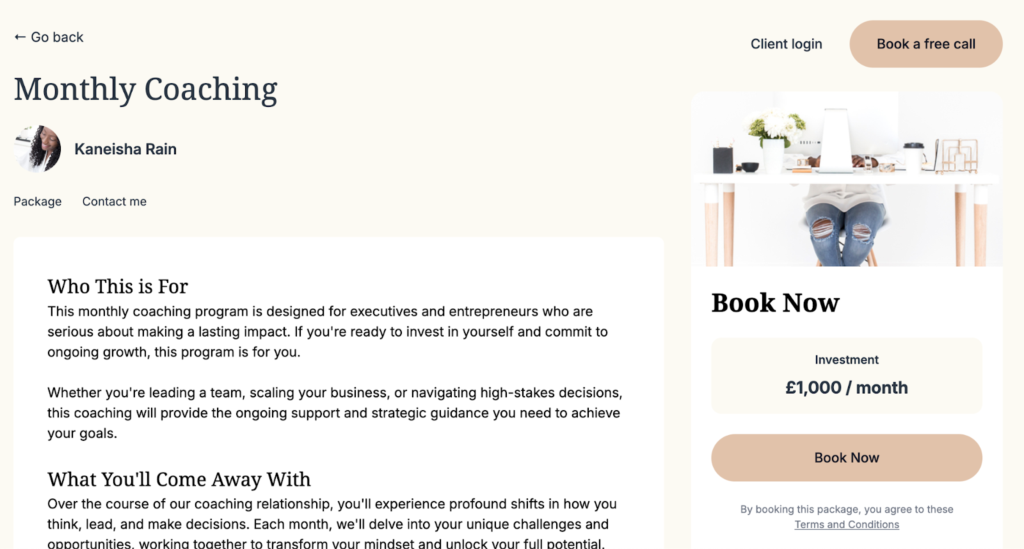
Clients can simply pay you, sign your contract, and book their first appointment in a few clicks on your personalized Paperbell website. All their information will be safely stored in your account.
How to Set Up A Package in Paperbell
First, click on ‘Packages’ and then ‘Create New’ to start.
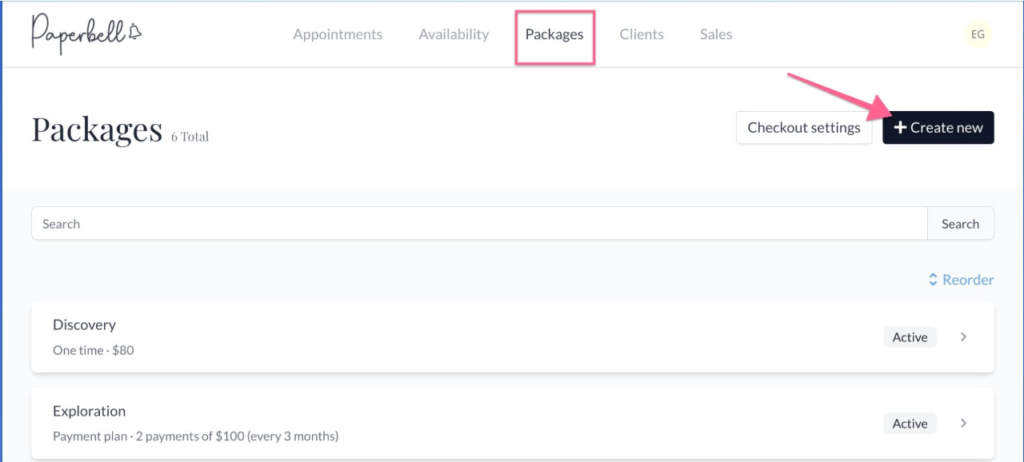
Then, define the type, length, and number of appointments you’d like to offer in this package, such as one-on-one or group coaching sessions.
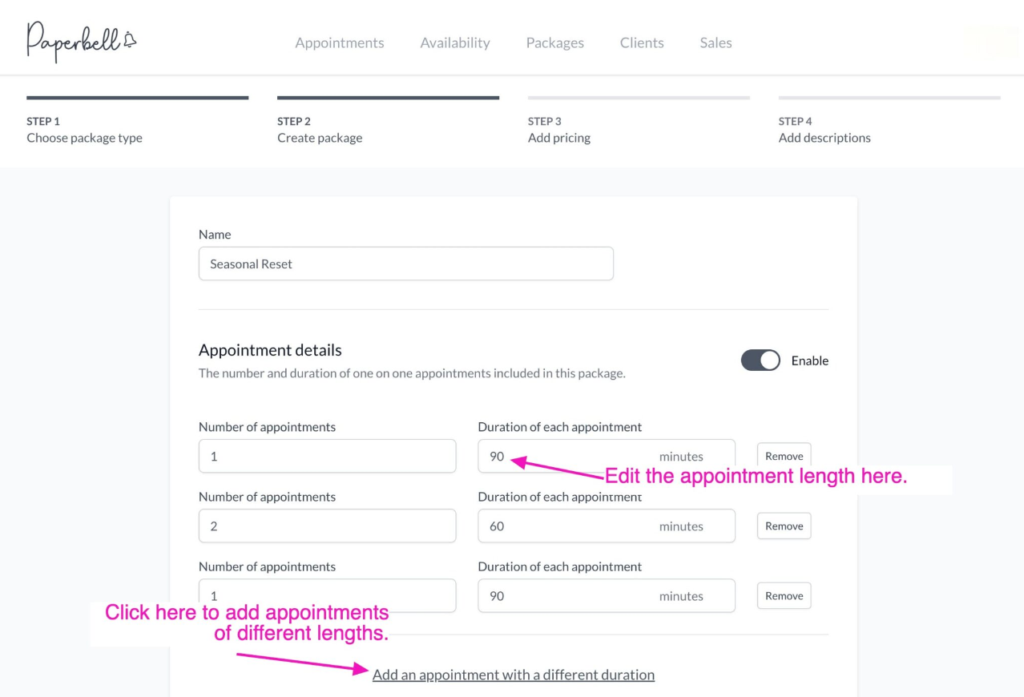
Next, set the pricing for your package. You can choose from one-time payments, subscriptions, or payment plans with installments due at your preferred dates.
You can also offer coupons for clients, for example, who wrote testimonials for you or signed up early. Optionally, you can also add surveys or bonus materials to your packages, like courses or downloadable worksheets. Once your package structure is set, you can simply customize its landing page with your design preferences and content to start selling it.
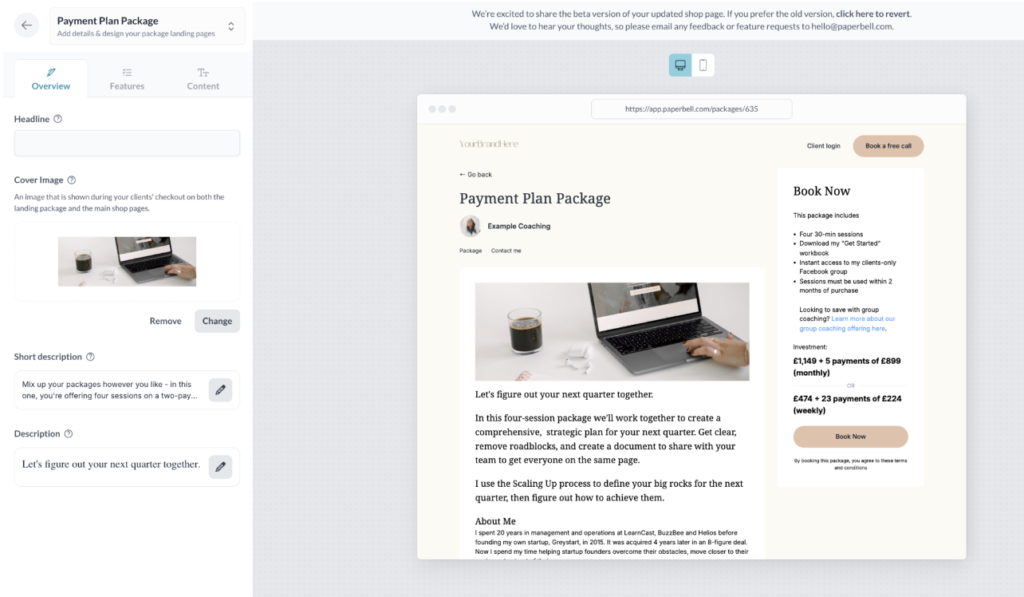
Your package is now ready for sign-ups, featuring fully integrated automated scheduling, payments, and client management.
You can keep it public on your Paperbell website or make it invite-only for private clients.
Understanding Your Target Audience
Before diving into the know-how of crafting packages, it’s important to define your target audience.
Creating services will be like shooting in the dark without understanding who you’re selling to. Take the time to define your audience, what makes them tick, and the hurdles they face.
It’s not just about demographics but understanding their pain points and aspirations. This insight will guide your packages, including their purpose, the materials you want to develop for them, and the methods that will resonate with your clients.
It’s the difference between offering generic advice and delivering a personalized roadmap to success.
As coaches, we love powerful questions. So here are a few guiding questions you can use to define your target audience:
- What is the age range of the clients I want to coach?
- What industries or professions are they likely to be a part of?
- What career stages are they in, and what are their professional goals?
- What specific challenges or issues are they seeking help with?
- What goals or aspirations do they want to achieve through coaching?
- What are their values, beliefs, and interests?
- What lifestyle choices and habits are common among them?
- What is their income level or budget for coaching services?
Once you’ve created your target audience profile, you might notice some gaps in the information you have about your clients. In this case, you can do further research through surveys and interviews to refine your avatar even further.
What Should I Include in My Coaching Package?
There are four key elements of a well-structured life coaching package:
- Duration
- Outcome
- Format
- Price
Paperbell lets you completely customize your packages with all of these elements in mind so that you can run your coaching practice by your own design.
Let’s look at how each of these four pillars is reflected in a package.
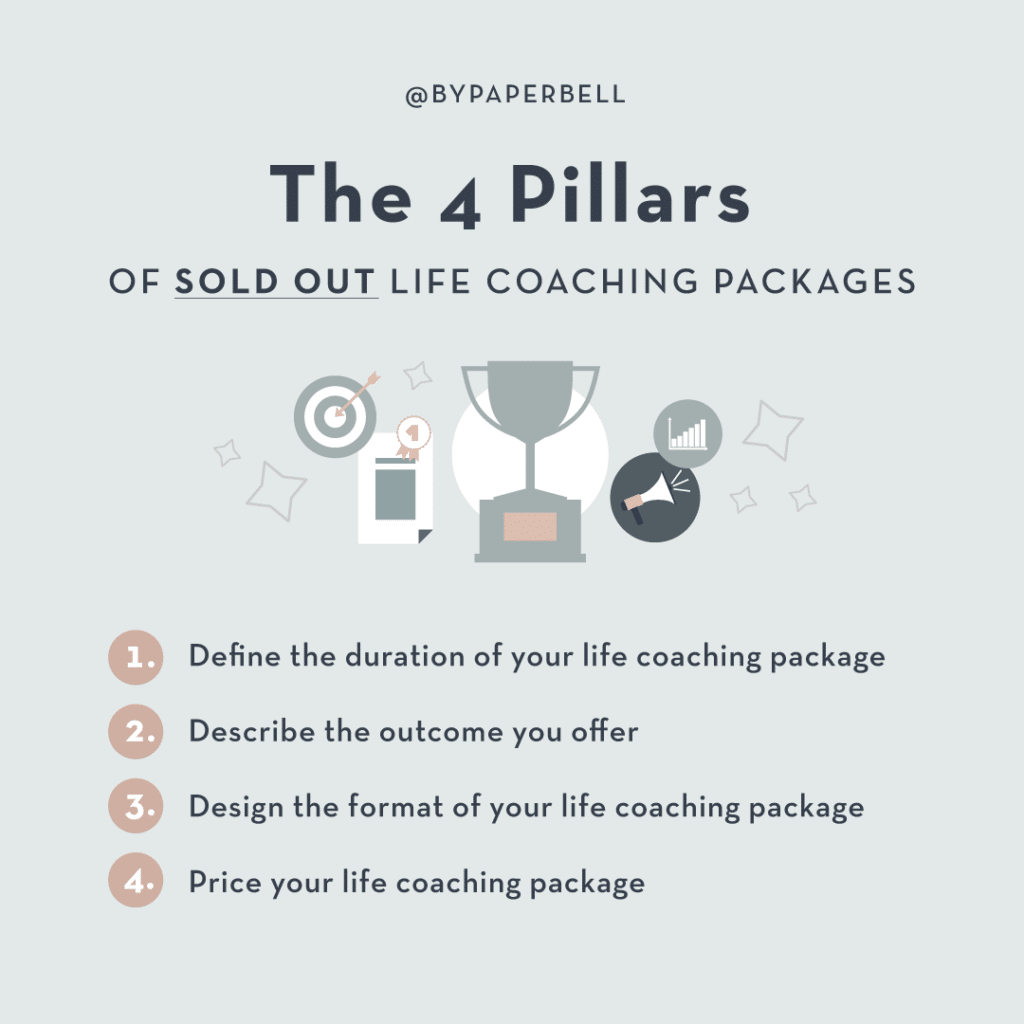
How to Create a Life Coaching Package
1. Define Its Duration
The simplest way to turn individual coaching sessions into a package is to offer a set number of them within a given timeframe.
If you have a set timeline for your collaboration, it’s also easier to define clear objectives with your client for that duration. It shows that their time with you is an investment that will pay off.
Most coaches define a minimum timeframe for a coaching relationship and offer a lower rate for clients who commit longer. For example, if your one-month package has four sessions for $1,000, you can offer a three-month coaching package with 12 sessions for $2,500.
2. Describe the Outcome You Offer
The more specific your offer, the more likely it will connect with the right audience. This is why addressing your niche is key.
A 4-Week Program To Build A Thriving Love Relationship has a clear value proposition, unlike a general Change Your Life coaching program.
Even if you’re a coach specializing in multiple niches, you need to make each life coaching package specific to its focus. This way, you’ll specify the results your coaching client will get.
You might think, “But I’m a holistic coach; why should I limit myself?” But if you have to choose between a jack of all trades and a specialist in an area you’re struggling with, wouldn’t you turn to the specialist?
Plus, holistic outcomes can be defined specifically, for example:
- Achieving a greater balance between work, love, and play
- Feeling more grounded and confident
- Developing greater self-awareness and making more conscious life choices
That’s why building various coaching packages is a brilliant way to emphasize the outcome you’re creating with each of them for your clients.
If you design your packages with Paperbell, you’ll automatically get a beautiful landing page for each within a ready-made website. It’s like a menu your clients can choose from, knowing what each delivers.
Check out this example of a Paperbell website to see how packages would look live.
3. Design the Format of Your Package
It’s not just the content of your sessions that makes them so powerful, but the format or framework you follow too.
Do you offer 1-on-1 sessions, group coaching, or a mix of both?
Will they be a part of a community or work only with you?
Are there materials or a self-study course you offer access to?
Can your clients reach you between the sessions for chat support, accountability, or crisis management?
These are important questions to answer so you can decide how much value you want to offer throughout the coaching relationship. It doesn’t mean you have to cram all possible bonuses or stretch yourself with extra client support—quite the opposite.
Defining the format of your coaching package and what it includes sets the right expectations upfront for your client, as well as the necessary boundaries for you.
4. Price Your Life Coaching Packages
There’s a reason why this step comes last. It’s difficult to price a package unless you’re clear on what it includes and the value it offers to your client.
Now that you have a breakdown of your life coaching package, you can roughly estimate the value of each individual element in it (sessions, materials, and so on) and add them up.
The idea is that you break down the overall value of your package and offer a generous discount, which is why you’re creating a package in the first place. You’re maximizing the outcome of the collaboration and making it a simple yes or no buying decision for your coachee.
The other way to approach your pricing is to compare similar offers in your niche. If you want to know what other life coaches charge, download our free report.
Take a look at coaches who work with similar clients and offer the same format as you do. Then, check their prices on their websites or simply ask for a quotation.
Your rates will largely depend on your expertise level, previous clientele, and media presence. You are the biggest asset in your business, and with time, growing your brand as a coach can create more demand for your services. Consequently, a higher interest in your services will increase your ability to charge higher rates.
[ Read: Steal This Template for Your Complete Brand Strategy ]
When Should I Raise the Prices of My Life Coaching Packages?
Generally, it’s a great idea to raise your prices when your schedule is close to being fully booked. In other words, you’re reaching maximum capacity to work with clients in a given month or year.
If you don’t have as many bookings as you would want to, it might be a better time to work on improving your offer and marketing initiatives first. This might mean looking for ways to give your clients more value or developing a more persuasive marketing strategy.
An alternative to raising your rates is to develop new products or packages. This way, you can create a new revenue stream or open up a new market niche without overcharging your clients.
A Simple Life Coaching Package Template to Get Started With
Here’s a template you can follow to create a life coaching package.
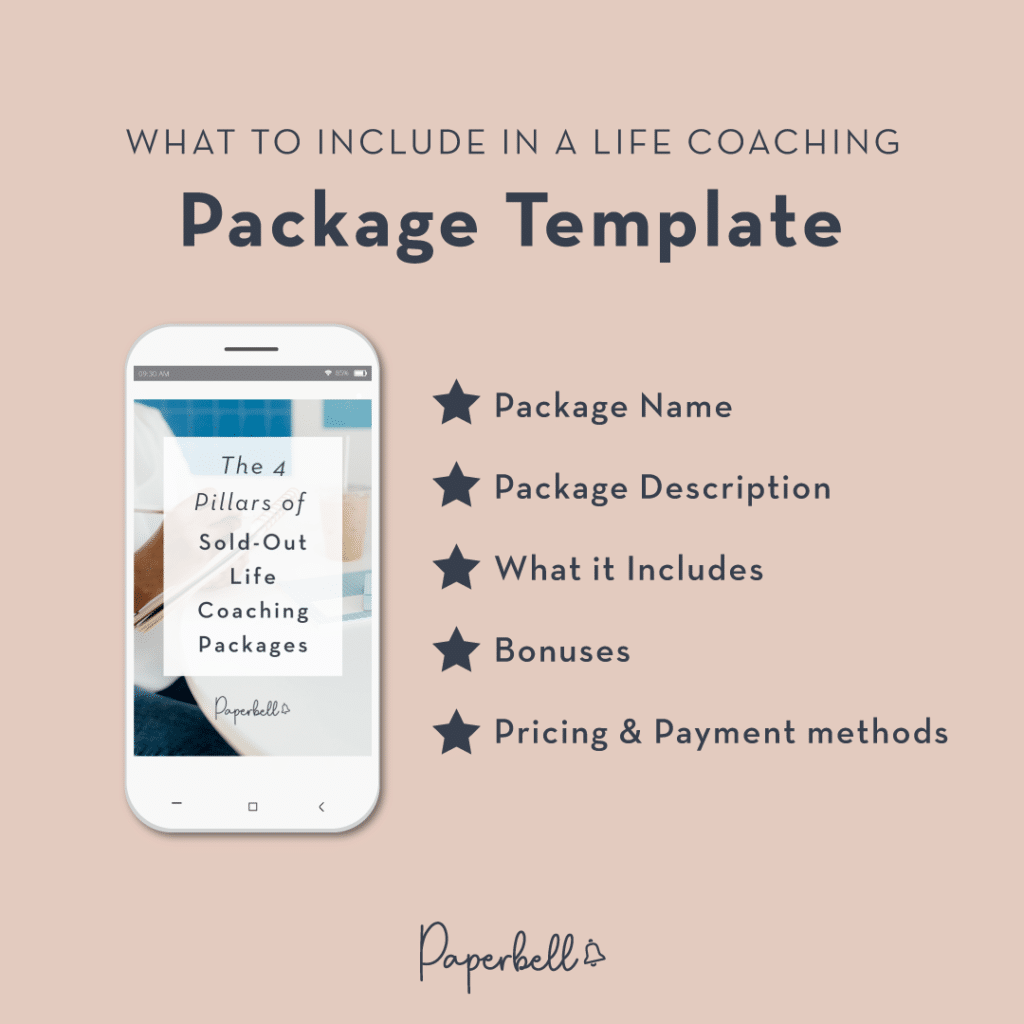
Package Name
Give a catchy name to your package that describes the outcome it brings to your clients. In the context of your other packages, this might describe the duration of the coaching relationship or the niche it focuses on.
For example, you can offer a Foundations of a Thriving Relationship package for first-time clients and an Emotional Mastery Bootcamp for those who want to dive deeper.
Package Description
This is where you explain who this package is for, its focus, and how long you’d be working together.
Describe the problems your client is facing and how your package is the solution for them. Explain the process you follow and the outcome they will get once their coaching journey is complete.
For example, you may describe your package this way:
This is an 8-week coaching journey where you’ll go from financial stress and limitations to creating abundance in your life and mastering your money mindset. We’ll do this by identifying your limiting beliefs around money and replacing them with more empowering thoughts, as well as proven methods to manage your finances with joy.
What It Includes
Now, you need to outline all elements of your coaching package. You can simply list them in bullet points. Be as specific as you can!
Here’s an example:
- Six 90-minute online coaching calls
- Vox support between sessions
- Access to our invite-only community for peer support
- Lifetime access to the Foundational Mindfulness Self-Study Course
Bonuses
Bonuses are elements of your package that aren’t necessarily required for clients to get to their desired outcome, but they can provide additional value.
This might be an ebook, a group coaching call at the end of the program, or a discount on your future packages.
Pricing and Payment Methods
As we’ve covered, you must first estimate your package value based on its market value. Consider your level of specialized expertise, the results you have delivered in the past, and how much your competitors charge.
Next, you have an option to create different package tiers. For example, you can offer different prices for the same package with or without bonuses. You can also offer a self-study course versus a group coaching program where clients go through the same material together and get personalized guidance.
It’s best not to offer too many options for your clients because it might overwhelm them with choices.
Last but not least, you can create different payment plans for your clients and reward those who pay in full with a better rate. For example, if your 3-month coaching package costs $3,000 in full, you can offer monthly installments for $1,200.
Setting up package tiers, payment plans, or even memberships is easy with Paperbell as well. All it takes is a simple form.
How to Sell Your Life Coaching Packages
Here are three things you need to start selling your life coaching packages.
[ Read: The Overwhelmed Life Coach’s Guide to Marketing ]
Branding Assets
A coaching website is essential to showcase who you are, what you do, and your expertise. Once again, with Paperbell, this only takes a few clicks.
Gather testimonials from your previous clients or create anonymous case studies of the results you’ve achieved with your packages. Perfect your bio with your origin story, professional experience, and the publications you’ve appeared in.
A video of you can go a long way in establishing a connection with your prospects and inspiring them to get in touch with you.
Besides your website, you can also create a presentation deck of your packages where you go into more detail.
Some coaches prefer to only share their rates in their pitch deck or on an unlisted landing page only shown to prospects. Others like to be transparent about their prices and list them publicly on their website.
It’s completely up to you which one you choose. Just make sure the value you offer is crystal clear in all your branding assets.
Content
A great way to build an audience is to set up an email list and send out newsletters centered around your expertise. A free resource on your website can be a great incentive for potential clients to sign up for your list.
Contrary to popular belief (and societal pressure), it’s not an absolute must to grow your social media following to get clients. However, sharing regular content about what you do is a great way to create visibility for your services.
Choose a social media channel where your target audience is most likely to hang out, one that best fits the type of content you want to share. You can create a buzz for your business coaching clients on LinkedIn or share more in-depth insights on Medium. If your clients are Gen Z, you might want to hop on the TikTok train.
Outreach
A more targeted way to connect with ideal clients is to seek them out and pitch your services to them directly. Many coaches source their prospects on LinkedIn, Facebook, or Instagram and sell their services to them through messages.
The other way to reach potential clients is through their email addresses. You may do this through the contact form on their websites or by asking for an introduction within your professional circle.
The more specifically you define who could benefit from your services, the easier you’ll find your ideal clients—without your emails and messages landing in the spam folder.
Start Creating
Now, it’s time to design your life coaching packages and woo your prospects with them.
Paperbell lets you customize them with payment plans, subscriptions, digital downloads, and more. Get your free account now to start creating.
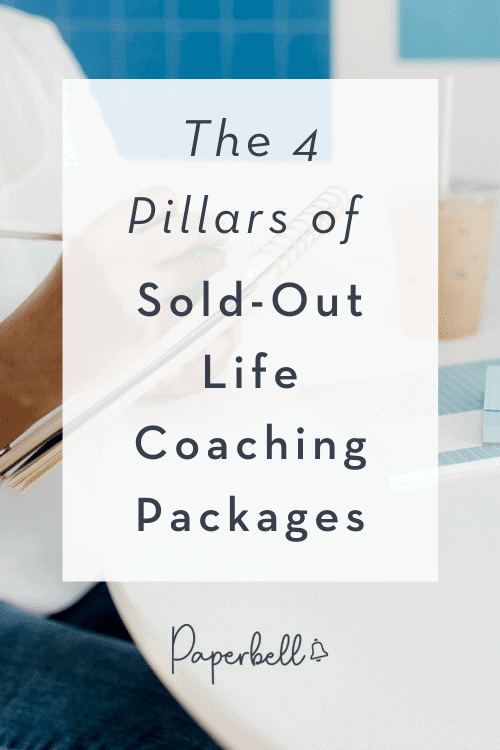
Editor’s Note: This post was originally published in July 2021 and has since been updated for accuracy.
